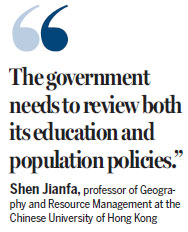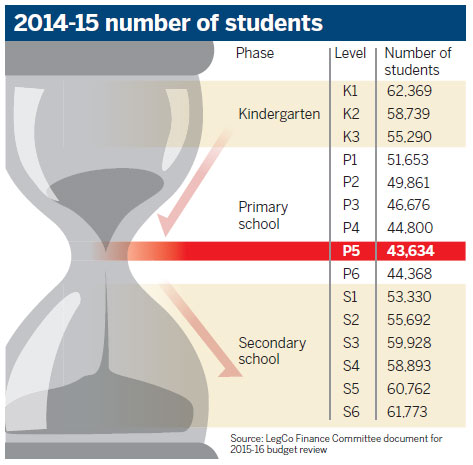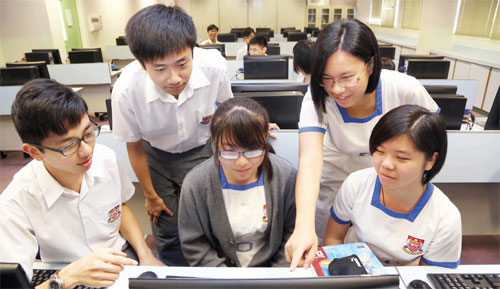Demographic changes shaking up education
Updated: 2015-07-23 09:04
By Luis Liu in Hong Kong(HK Edition)
|
|||||||
Experts urge review of policies affecting schools to deal with population shifts
The city's education professionals are urging the government to review secondary school policies to tackle the likely impact on the education sector of future demographic changes in Hong Kong.
One sign of this was the announcement early this month by education authorities that they will not review the city's teaching medium scheme, despite falling English language standards.
Under the current policy introduced in 2009, an English-medium school needs to switch to Chinese if it fails to meet required standards after a six-yearly review. The requirements are subject to "student ability" criteria. This means a school should fill 85 percent of places with the "top 40 percent" of students in terms of academic ability.
Falling student numbers caused by low birth rates mean one-third of these schools have been admitting students who do not qualify under the current system, Education Bureau (EB) figures show.
Since about a decade ago, the shrinking child population of Hong Kong has prompted the government to start closing down many primary schools. But as the number of such children is now increasing, the education sector is facing the problem of insufficient primary schools and teachers.
There are warnings that the same thing will soon happen to secondary schools. Experts say the recent controversy over the teaching medium is an early warning. Educators and scholars are urging the government to adopt a more forward-looking policy.
The EB closed some schools due to the decreasing number of students to "wisely use public revenue and eliminate some incompetent schools". This has been said to lower the morale of teachers and will ultimately hurt the interests of students.
Education columnist Wong Ka-leung said the previous wave of closures of primary schools had already made a number of teachers unemployed. This has also deterred many aspiring graduates from joining the teaching profession. This was now happening with secondary schools, Wong said.
It has resulted in a shortage of professional teachers in certain age groups. This might ultimately hurt the students when their numbers start to increase, explained Wong.

But the EB said the number of newly hired teachers had actually been stable in recent years. It currently stood at 1,000 per year. There was no shortage of capable young teachers, it added.
Meanwhile, an average secondary school class currently consists of 30 students. Education Convergence (EC) estimated that a total of 41 classes will be reduced.
EC Vice-President and Principal of Chinese secondary school Elegantia College Ho Hon-kuen said the EB should further lower the minimum student intake per class to 22, to take advantage of the "opportunities" provided by this population shrink.
The EB predicts that if the number of students per class in secondary schools is reduced to 20, education costs per student will double to HK$80,000. This will raise the total education budget by HK$5.6 billion.
Local demographers are looking at the long term. In his study on Hong Kong's population problems, Professor of Geography and Resource Management at the Chinese University of Hong Kong, Shen Jianfa, said that to keep Hong Kong's population steady, the number of secondary school students should reach 83,858 - almost double the current level.
He warned that reducing classes and closing schools would not address this issue. He urged the government to review both its education and population policies.
luisliu@chinadailyhk.com

|
Educators and scholars are urging the government to adopt a more forward-looking policy to minimize the impact of demographic changes on secondary schools and their students. Photo provided to China Daily |
(HK Edition 07/23/2015 page7)
